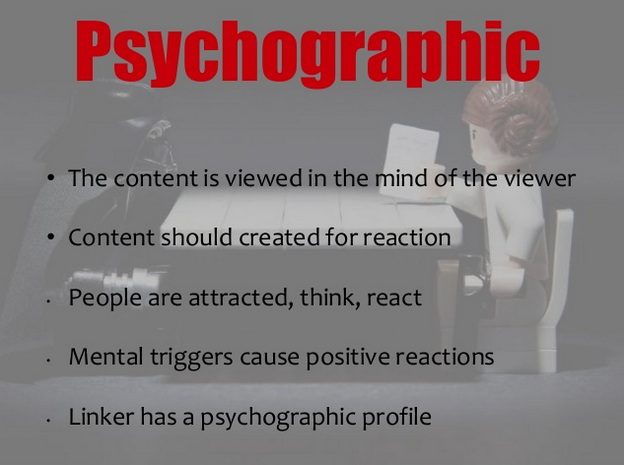
The above is the most clipped slide from my Content Publishing Strategy presentation on Slidedeck.
This presentation forms the backbone of the content strategy training I offer and the aspect of the “psychographic profile” is always the most interesting to people.
People think content is king, but this is wrong. Content is merely the vehicle for the idea.
The real action happens in the mind of the reader. It’s not the content that the focus should be on, but the psychology of the person it is aimed at.
The mind of the target reader must define the content, not the creator’s whim and fancy.
I’ve worked with a lot of creatives and a lot of them seem to be focussed more on a particular aspect they are interested in such as infographics, or a new javascript trick, than the actual job which is to communicate and influence the reader to perform a specific action.
But that’s not what Shakespeare and Hemmingway did, they were true artists!
No.
That is exactly what they did. They looked at what triggered the audience to action. What ideas infected the minds of their target audience. Shakespeare was a brilliant content publisher and we could spend a few hours discussing this but lets not get distracted.
Lets get back to links.
Forget most of the guff talked at you by PR people who wear very heavy watches that are advertised in magazines with pictures scantily clad women.
Links are the key, they are what get you ranked in Google.
Ranking in Google is still the best way to get people to your website and buy stuff.
To get links, you need to influence the people who give links.
To influence people to give links you need to know what would make them link.
Content is not the trigger, it’s the idea behind the content. Thus it’s all about what is happening in the mind of the reader who can link.
- Who are these people?
- What do they read?
- What websites do they look at?
- How old are they?
- What apps do they use?
- Are they an Open World, MMO gamer or do they prefer Candy Crush on a smartphone.
These and a hundred more questions such as these, need to be asked in order to know what actually communicates to and influences your target linker.
Because it could be as simple as a picture of a kitten, or as complex as an interactive HTML5 driven infographic.
Getting links used to be simple, but cutting edge, link building theory has become a lot more complex.
Psychology and neuroscience are subjects that need to be studied if you want success in the digital marketing landscape of today.